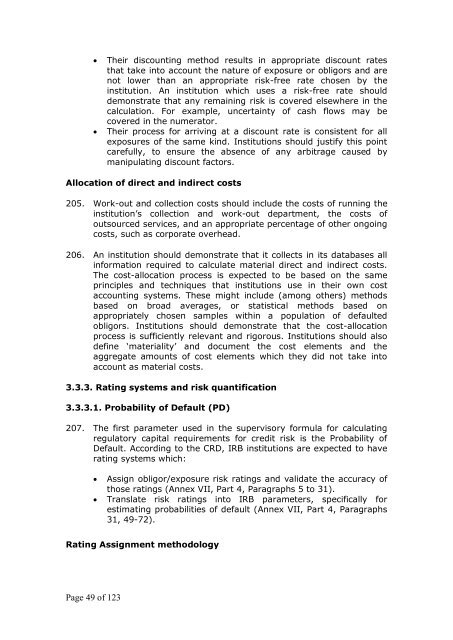CP10 (Full Document) - European Banking Authority
CP10 (Full Document) - European Banking Authority
CP10 (Full Document) - European Banking Authority
Create successful ePaper yourself
Turn your PDF publications into a flip-book with our unique Google optimized e-Paper software.
· Their discounting method results in appropriate discount rates<br />
that take into account the nature of exposure or obligors and are<br />
not lower than an appropriate riskfree rate chosen by the<br />
institution. An institution which uses a riskfree rate should<br />
demonstrate that any remaining risk is covered elsewhere in the<br />
calculation. For example, uncertainty of cash flows may be<br />
covered in the numerator.<br />
· Their process for arriving at a discount rate is consistent for all<br />
exposures of the same kind. Institutions should justify this point<br />
carefully, to ensure the absence of any arbitrage caused by<br />
manipulating discount factors.<br />
Allocation of direct and indirect costs<br />
205. Workout and collection costs should include the costs of running the<br />
institution’s collection and workout department, the costs of<br />
outsourced services, and an appropriate percentage of other ongoing<br />
costs, such as corporate overhead.<br />
206. An institution should demonstrate that it collects in its databases all<br />
information required to calculate material direct and indirect costs.<br />
The costallocation process is expected to be based on the same<br />
principles and techniques that institutions use in their own cost<br />
accounting systems. These might include (among others) methods<br />
based on broad averages, or statistical methods based on<br />
appropriately chosen samples within a population of defaulted<br />
obligors. Institutions should demonstrate that the costallocation<br />
process is sufficiently relevant and rigorous. Institutions should also<br />
define ‘materiality’ and document the cost elements and the<br />
aggregate amounts of cost elements which they did not take into<br />
account as material costs.<br />
3.3.3. Rating systems and risk quantification<br />
3.3.3.1. Probability of Default (PD)<br />
207. The first parameter used in the supervisory formula for calculating<br />
regulatory capital requirements for credit risk is the Probability of<br />
Default. According to the CRD, IRB institutions are expected to have<br />
rating systems which:<br />
· Assign obligor/exposure risk ratings and validate the accuracy of<br />
those ratings (Annex VII, Part 4, Paragraphs 5 to 31).<br />
· Translate risk ratings into IRB parameters, specifically for<br />
estimating probabilities of default (Annex VII, Part 4, Paragraphs<br />
31, 4972).<br />
Rating Assignment methodology<br />
Page 49 of 123

















